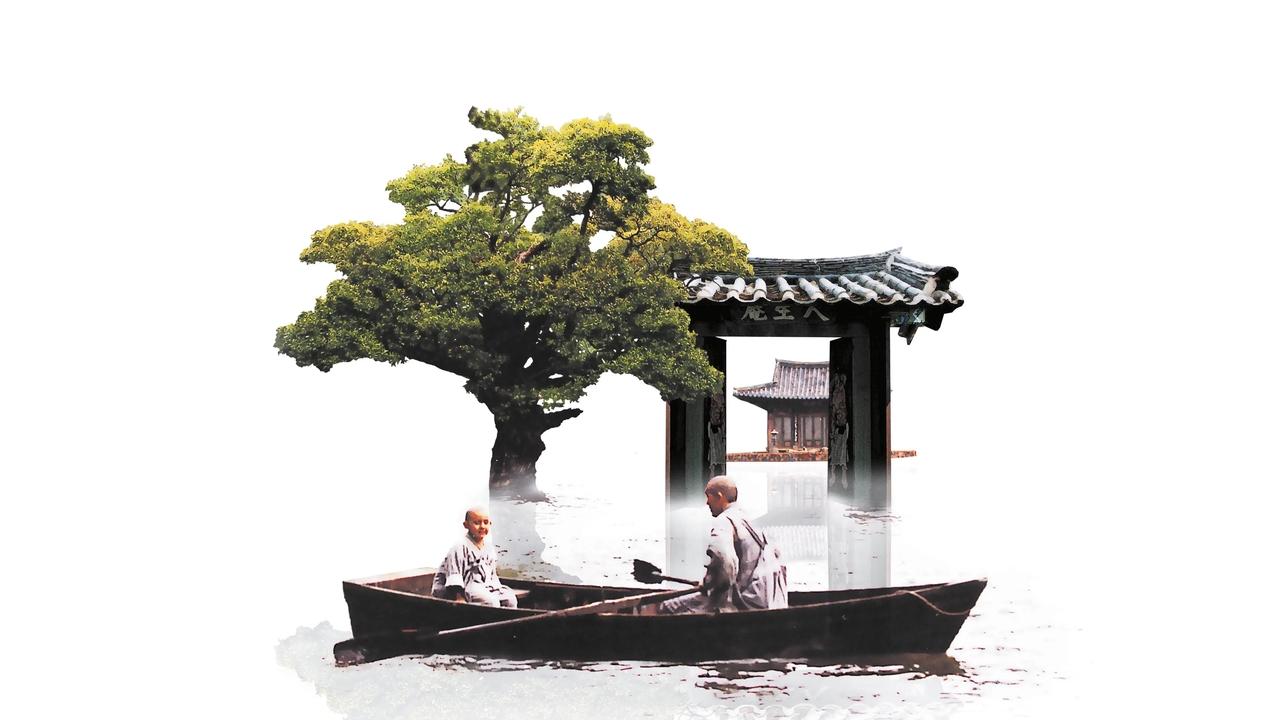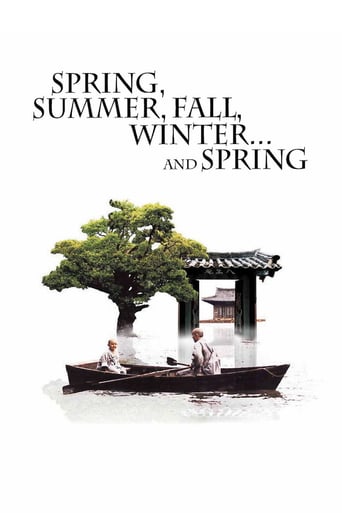Tacticalin
An absolute waste of money
Connianatu
How wonderful it is to see this fine actress carry a film and carry it so beautifully.
Grimossfer
Clever and entertaining enough to recommend even to members of the 1%
Brendon Jones
It’s fine. It's literally the definition of a fine movie. You’ve seen it before, you know every beat and outcome before the characters even do. Only question is how much escapism you’re looking for.
jamesharrison-01173
This movie just got way too dark and disturbing for me. Such is life however, moments of happiness and moments of pain and suffering. Does its job of driving home the Buddhist view on life as well as cycles and the seasons. There are things to be learned from this film.
kamillazhangulova
Spring, Sumer, Fall, Winter... and Spring is a South Korean movie about unusual Buddhist monastery that floats on a lake which is surrounded by forest. This movie showcases the life story of a Buddhist monk from his very early childhood till the time of his old age. While the titular seasons - spring, summer, autumn, and winter are really represented in the time in which they were claimed to be, as it probably can be guessed, they are not just associated with the real seasons, but they also are allegorically addressing quite convoluted path of a young monk. There is not much dialogues, or a background narrative voice which would have explained what is happening in the story (while sometimes it would be good to have it), but still scenes are showed in such a way that it definitely grasps the attention of the viewer right till the last minute of the movie. Film is packed with numerous allegories, and cultural peculiarities of South Korea (through which indeed differences in Buddhism practices according to regions can be traced) which would entertain the auditory by their sophisticated, and nuanced exhibition. In my opinion, this movie deserves to be watched at least due to its quite unusual but incredibly exciting style of story representation.
Movie starts with a rather spectacular scene depicting the day-to-day routine of a Buddhist apprentice and his master. What is interesting about these scenes is the strange presence of doors when there are no walls, and right from this moment it starts to seem that movie is going to be a quite capturing one. An apprentice is just a small boy, who seems rather childish and who tries to do everything as his master does. But, once he decided to "play" with a fish, frog, and a snake by tying small stones to them and laughing as they struggle. His master is watching at these three occasions all along the way. Then, in the night, in order to teach his apprentice of his incorrect actions he tied a stone, just proportionate to his size. When the boy wakes up and finds himself tied with a stone, he asks his master for help. But his Master claims that only after he would free the creatures from the torments which boy imposed on them, the master would release him. The boy becomes really surprised and amused when he realizes that his 'game' has tortured the creatures, and that snake, and a fish had died. I think that this scene is on what this movie stresses its focus because it very vividly depicts the danger of ignorance, and pursuit of one's unthoughtful desires.
Later, in the "Summer", the story plot is occurring around the young lady that was brought into the monastery because of her illness, and the love to which a young apprentice would fall with her. After his Master would know about their relationships, and sends apprentice's "girlfriend" back, an apprentice will escape from the monastery leaving his Master alone in order to pursue his love. But, this story does not actually have a "happy ending". In the "Autumn" we see that frustrated and grief-stricken man who is looking for a refuge from the police since he has committed a crime. While the Master helps his apprentice to release his anger, stops him from suicide, and supports him - Master appears to be harshly disappointed. After the police had found the man and took him, we see that Master self-emulates him, which appears to be quite compelling scene because the Buddhist teaching does not accept it, and additionally it is a quite vivid scene.
The "Winter" depicts how a grown man, that had experienced all the "ugliness" of life, comes back to the monastery where has grown up. He spends some time in seclusion, which notably help him to ensure his spirituality before he himself becomes a Teacher to a young boy, that was brought to the temple by a woman that was in sorrow about her action. While some of the scenes seems rather unclear, and hardly understandable in a thorough way to one who is not quite accustomed to the culture of South Korea, and their way of practicing Buddhism, they certainly provoke a wide variety of strong emotions and questioning of these customs.
The film ends in an already "acquainted" scene - boy playing with stones and creatures. But, now it actually is a different boy. This movie unequivocally represents one of those art pieces which not only are worth watching once, but also for the second and third time as well since I believe every time, and every individual would understand it in a discrete way. This arises because of the "room" for imagination which the film cordially provides us for having our own perceptions about the matter of the film, but it simultaneously is depicting the fundamental wisdoms of Buddhism quite concretely.
dinarayessimova
The movie "Spring, Summer, Fall, Winter... and Spring" directed by a vanguard Korean director Kim Ki Duk is a pure illustration and the reading of the Buddhist dharma, core Buddhist teachings. The work can be torn apart into separate pieces of symbolism, yet seen as a complete cyclic work of art. Through the cyclicality of the nature and the life of one person the director could interpret basic Buddhist concept in a lens of cultural Korean Buddhism and the mystical premises which should not be taken presisely. Unlike Weerasethakul's "Uncle Boonmee Who Can Recall His Past Lives" the cyclicality as an essential part of the Buddhist dharma has been shown from a slightly different perspective. The driving force for samsara has not only been the deed of one person, as we have partially observed from Uncle Boonmee, Kim Ki Duk illustrated cyclicality in all aspects of the world: from the rotation of day and night, change in seasons to the evolution of human emotions and senses to the change in generations. Even the title of the movie cyclical, as the Buddhist teachings suggest that time is not linear rather cyclical. Here the viewer comes back to the point zero at the end of the movie as well. It has been illustrated not only through the return to the spring season, which can be seen as the point of rebirth: we see the monk with the little boy both in the beginning and in the end. Other seasons can also be seen as other processes of this cycle: summer is birth, fall is life and winter is death. They can be in different levels at the same time: the development of nature, life of the old monk and life of a little boy. Even though the movie represents the small sangha, the monastic community, everything depicted by the director should not be taken literary, because it involves mystery, which is not explained by the movie. For example, even small details of the monastic life have not been shown and can raise some question: for example, the sources of food they have used to live. Another controversial moment in the movie is the one when the little boy has arrived on another shore and played with fish, frog and snake (which has been shown for the didactic reasons, as the viewer gets to see later), the old monk has also somehow arrived at that side of the shore, possibly just walking on the water. Leaving this questions without the answer, the director almost points out on the fact that even though the representation of the Buddhist livelihood seems more or less accurate, it should not be taken without a doubt. Despite this, Kim Ki Duk masterfully showed 3 Jewels on Buddhism: the Buddha, who has been depicted several times throughout the movie, Sangha, monastic community, and the Dharma, Buddhist core teachings. Even the Dukha, the suffering, which is the main driving force of Samsara, has been shown not only through different types and degrees of physical pain, but also through the moral dissatisfaction and psychological suffering: "Didn't you know beforehand how the world of men is? Sometimes we have to let go of the things we like. What you like, others will also like," - as the old monk commented after the younger one's return to the temple.Even though the movie includes a lot of controversial moments, it could masterly introduce to the viewer core concepts and teaching of Buddhist community, however, the viewer should take responsibility to filter and polish the information.
inioi
Poetic and influenced by Buddhist thought, this movie is a work of art in every way.It is obviously not for everyone, as his pace, almost without spoken script, and inherent philosophy, requires open minded and introspective viewers.Filming is in line with the script. Everything happens in due time. Neither before nor after. The life cycle is shown with detachment and objectivity. The destination which has come into existence on the first day of birthing is unfolding, and it will determine our lives until we begin to be aware of our actions.Actually, the film is similar to a Buddhist story.As the Old Zen Masters said: "Do not despise the story. A lost gold coin is found by means of a penny candle; the deepest truth is found by means of a simple story."8,5

